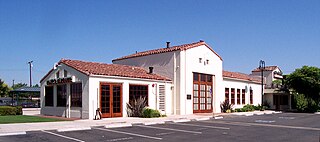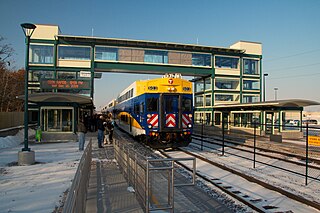
Exo, officially known as Réseau de transport métropolitain, is a public transport system in Greater Montreal, including the Island of Montreal, Laval, and communities along both the North Shore of the Mille-Îles River and the South Shore of the St. Lawrence River. It was created on June 1, 2017, taking over from the Agence métropolitaine de transport. The RTM operates Montreal's commuter rail and metropolitan bus services, and is the second busiest such system in Canada after Toronto's GO Transit. In May 2018, the former Réseau de transport métropolitain (RTM) was branded as Exo.

The Metro Blue Line is a 12-mile (19.3 km) light rail line in Hennepin County, Minnesota, that is part of the Metro network. It travels from downtown Minneapolis to Minneapolis–Saint Paul International Airport and the southern suburb of Bloomington. Formerly the Hiawatha Line prior to May 2013, the line was originally named after the Milwaukee Road's Hiawatha passenger train and Hiawatha Avenue, reusing infrastructure from the former and running parallel to the latter for a portion of the route. The line opened June 26, 2004, and was the first light rail service in Minnesota. An extension, Bottineau LRT, is planned to open in 2028.

Brewster station is a commuter rail stop on the Metro-North Railroad's Harlem Line, located in Brewster, New York.

The Northstar Line is a commuter rail route in the US state of Minnesota. Northstar runs 40 miles (64 km) from Big Lake to downtown Minneapolis at Target Field using existing track and right-of-way owned by the BNSF Railway. Passenger service began on November 16, 2009. The rail line serves part of the Northstar Corridor between Minneapolis and St. Cloud. Planning for the line began in 1997 when the Northstar Corridor Development Authority (NCDA) was formed. The corridor is also served by Interstate 94 and U.S. Highway 10. In 2023, the system had a ridership of 142,200, or about 500 per weekday as of the fourth quarter of 2023.
Metro Transit is the primary public transportation operator in the Minneapolis–Saint Paul area of the U.S. state of Minnesota and the largest operator in the state. Metro Transit has previously been ranked as one of the best public transit systems in the United States. In 2023, the system had a ridership of 44,977,200, or about 145,600 per weekday as of the fourth quarter of 2023.

Saint Paul Union Depot is a historic railroad station and intermodal transit hub in the Lowertown neighborhood of Saint Paul, Minnesota. It serves light rail, intercity rail, intercity bus, and local bus services.

Danbury station is a commuter rail station on the Danbury Branch of the Metro-North Railroad New Haven Line, located in Danbury, Connecticut. The station is the northern terminus of the Danbury Branch.

Orange station, formally the Orange Transportation Center, is an intermodal transit station in Orange, California. It serves Metrolink trains as well as Orange County Transportation Authority buses. The station is located at the site of two former Atchison, Topeka and Santa Fe Railway combination depots. The present depot structure was dedicated on May 1, 1938, and was closed with the Santa Fe's discontinuation of passenger service in 1971. The building was granted historic landmark status by the City on November 15, 1990.

St. Cloud station is an Amtrak intercity train station in St. Cloud, Minnesota, United States. It is served by the daily Empire Builder on its route connecting Chicago, Illinois to Seattle, Washington and Portland, Oregon. The next stop westbound is Staples while the next stop eastbound is Saint Paul Union Depot.

Target Field station is a multimodal commuter train and light rail station in Minneapolis, Minnesota. Located in the North Loop area of Downtown Minneapolis, the station is named for Target Field, the Minnesota Twins baseball stadium. METRO Blue Line light rail service started on November 14, 2009; Northstar Line commuter rail service started November 16, 2009; METRO Green Line light rail service started on June 14, 2014.
The Minneapolis Streetcar System was a proposed streetcar system for the city of Minneapolis, Minnesota. Extensive studies and plans for the new system were completed in 2007 and presented to the Minneapolis City Council in January 2008; on April 2, 2010, the Council voted to approve the plans and seek funding. On December 21, 2010 the Federal Transit Administration granted $900,000 to further study the Nicollet and Central Avenue corridors. In June 2021, after no further development on the system, a bill authorized the Metropolitan Council to use funds collected for the Nicollet-Central line to be spent on bus rapid transit funding.
There are several passenger rail projects being discussed in Minnesota. There is one existing commuter rail service in the state, the Northstar Line, and one existing long-distance intercity rail service, the Empire Builder. Future projects include a mixture of short-distance commuter rail and medium-distance regional rail lines which would run from the Twin Cities outward to neighboring states and perhaps Canada.

The Minneapolis Great Northern Depot, also known as Great Northern Station, was a passenger railroad station which served Minneapolis, Minnesota, USA. It was built in 1913 and demolished in 1978. It was located on Hennepin Avenue next to the Hennepin Avenue Bridge and across the street from the main Minneapolis Post Office.

The Jefferson Park Transit Center is an intermodal passenger transport hub in the Jefferson Park neighborhood of Chicago, Illinois. It serves as a station for rail and also as a bus terminal. Jefferson Park Transit Center's railroad station is on Metra's Union Pacific Northwest Line, with the station located at 4963 North Milwaukee Avenue. Jefferson Park is 9.1 miles (14.6 km) away from Ogilvie Transportation Center in downtown Chicago, the inbound terminus of the Union Pacific Northwest Line. Under Metra's zone-based fare system, Jefferson Park is in zone 2. As of 2018, Jefferson Park is the 97th busiest of Metra's 236 non-downtown stations, with an average of 510 weekday boardings.

Fridley station is a commuter rail station in Fridley, Minnesota, located at Main Street NE and 61st Avenue NE. It is served by the Northstar Commuter Rail line. The station features bicycle lockers and two park and ride lots with a total capacity of 611 spaces. The commute time to downtown Minneapolis from this station is about 20 minutes. The station has a single platform on one main track, which is accessible on either side of the tracks through a tunnel.

Coon Rapids–Riverdale station is a commuter rail station in Coon Rapids, Minnesota, located at 3050 Northdale Boulevard NW, south of the Riverdale shopping centers. It is served by the Northstar Commuter Rail line. The station features bicycle lockers and a park and ride lot with capacity for 466 vehicles. The commute time to downtown Minneapolis from this station is about 28 minutes. The fare to downtown Minneapolis from this station is $3.25 at all times; the fare to and from any other station is $3.25 on weekdays and $2.75 on weekends and holidays.

Elk River station is a commuter rail station in Elk River, Minnesota, located at 17200 Twin Lakes Road. It is served by the Northstar Commuter Rail line. The station features bicycle lockers and a park and ride lot with capacity for 754 vehicles. The commute time to downtown Minneapolis from this station is about 41 minutes. The normal fare to downtown Minneapolis from this station is $4.50 on weekdays and $4.00 on weekends and holidays; the fare to and from any other station is $3.00 on weekdays and $2.50 on weekends and holidays.

The St. Cloud Metropolitan Transit Commission, branded as Metro Bus, is the primary provider of mass transportation in St. Cloud, Minnesota. Service is provided daily using a fleet of 37 full-sized buses. The agency was formed in 1969 after the private St. Cloud Bus Lines began to cut routes and increase fares, leading the Minnesota State Legislature to establish a Transit Authority to make up for perceived inadequate service.

Metro is a transit network in Minnesota serving the cities of Minneapolis and Saint Paul. It also provides service to some suburban areas. As of 2022, the system consists of two light rail lines and five bus rapid transit (BRT) lines all of which are operated by the local public transit company: Metro Transit. The five lines connect Downtown Minneapolis and St Paul with the Bloomington, Minneapolis-St Paul International Airport, Roseville, Richfield, Burnsville and Brooklyn Center.

















